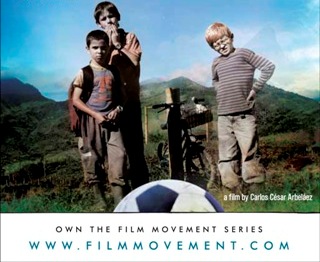Maven's Nest
Reel Life: Flick Pix


G –O–A–L – one soccer ball away from kicking into civil war
By Nora Lee Mandel
THE COLORS OF THE MOUNTAIN (LOS COLORES DE LA MONTAÑA)
Written and Directed by Carlos César Arbeláez
Produced by Juan Pablo Tamayo
Released by Film Movement
Colombia. 88 min. Not Rated in U.S.
In Spanish with English subtitles
With: Hernán Mauricio Ocampo, Norberto Sánchez, Genaro Aristizábal, Hernán Méndez, Carmen Torres, Natalia Cuéllar
As Manuel (Hernán Mauricio Ocampo) celebrates his ninth birthday, his life looks at first like an end-of-summer idyll. Amidst the lush green of the Andes Mountains in northwest Colombia, he helps his dad Ernesto (Hernán Méndez) milk the cows and his mom Miriam (Natalia Cuéllar) care for his baby brother. Best of all, there are enough kids around the local farms to team up on the soccer field, especially his older best friend Julián (Nolberto Sanchez). He even defends the bespectacled albino boy Poca Luz (Genaro Aristizábal), who gets picked on by bullies.
But their parents have more dangerous bullies to worry about, and the school didn't need the replacement teacher Carmen (Carmen Torres) to come way out here on the back of a truck just because it was closed for the summer. Debut director Carlos César Arbeláez consistently films from the politically-ignorant perspective of the children to gradually reveal that the village is caught between guerrillas and paramilitaries. In the background, Manuel's father avoids them, Julián's father hides his son from them, mothers flee in terror, and the new teacher thinks the kids can just paint over their slogans on the school wall with a colorful mural. To Manuel, they are just guys in ponchos and guys in jungle fatigues who chase through the mountains.
The conflict gradually impinges more on the children's daily lives than their parents' overheard anxious whispers and the emptying seats in the classroom. Where the poncho guys have gone one evening is the soccer field, and the kids' comical chase of a sow the next morning turns suddenly frightening about just how inexplicably and unavoidably violent being stuck in the middle is for the villagers. The kids don't really understand what land mines are even as the fathers mark the field with a red warning flag.
But Manuel got his first real soccer ball for his birthday and when it gets kicked beyond that marker, it becomes more fraught with fear and symbolism then a Hitchcock McGuffin. The eternal innocence of childhood irresistibly draws Manuel by the magnetic pull of that ball. He and his friends are as creatively clever as 19th century boys in a Mark Twain story in coming up with more and more devilishly ingenious attempts to reach it in the danger zone – climbing rocks around it, stretching out long sticks, swinging ropes over it, and skipping stones to it. The simple and stark contrast between their playfully childish attempts in that rustic field and the tension over the modern risk is heart-pounding and breath-stopping.
Luis Mandoki's Innocent Voices (Voces inocentes) (2004) showed how a similar civil war in El Salvador affected families, but was much more heavy-handed. Arbeláez cites Iranian films as a stylistic influence for a much more naturalistic use of children and local casting, even as he seems just a bit more hopeful that South America isn't quite as tragic as the Middle East--yet.
May 20, 2011
Nora Lee Mandel is a member of New York Film Critics Online and the Alliance of Women Film Journalists. Her reviews are counted in the Rotten Tomatoes TomatoMeter:
 Complete Index to Nora Lee Mandel's Movie Reviews
Complete Index to Nora Lee Mandel's Movie Reviews
Since August 2006, edited versions of many of my reviews of documentaries/indie/foreign films are at Film-Forward; since 2012, festival overviews at FilmFestivalTraveler; and, since 2016, coverage of women-made films at FF2 Media. Shorter versions of my older reviews are at IMDb's comments, where non-English-language films are listed by their native titles.
To the Mandel Maven's Nest Reel Life: Flick Pix
Copyright © 2018



